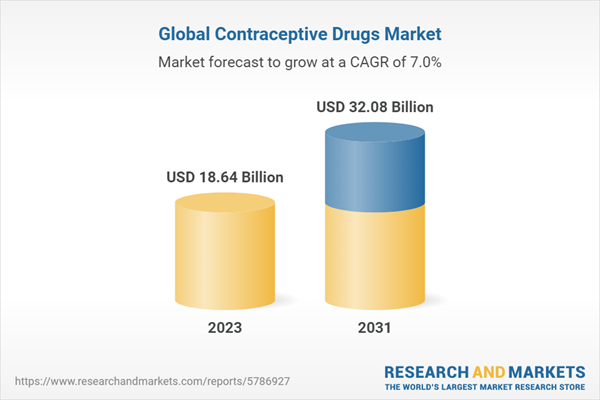The global contraceptive drugs market size attained a value of USD 17.42 billion in 2022. The market is further expected to grow at a CAGR of 7.02% during the forecast period of 2023-2031 to attain a value of USD 32.08 billion by 2031. The growth of the market is driven by the increasing awareness and acceptance of contraceptive drugs.
Contraceptive Drugs Market: Introduction
Contraceptive drugs are medications that are used to prevent unwanted pregnancies by suppressing ovulation, altering the cervical mucus to prevent sperm from reaching the egg, or changing the lining of the uterus to prevent implantation. These drugs are available in different forms such as pills, patches, injections, vaginal rings, and implants.
There are two main types of contraceptive drugs: hormonal and non-hormonal. Hormonal contraceptive drugs contain synthetic versions of the female hormones oestrogen and progestin, or progestin alone, which work by inhibiting ovulation. Non-hormonal contraceptive drugs, on the other hand, work by altering the acidity of the cervical mucus or by creating a physical barrier that prevents sperm from reaching the egg.
Contraceptive drugs are widely used by women around the world to prevent unwanted pregnancies and to space out births. They are a safe and effective method of birth control when used correctly, but like any medication, they can have side effects. It is important to talk to a healthcare provider to determine the best contraceptive option based on an individual's medical history, lifestyle, and preferences.
Contraceptive Drugs Market Segmentations
Market Breakup by Product Type
- Contraceptive Drugs
- Contraceptive Pills
- Patch
- Injectables
Market Breakup by Route of Administration
- Oral
- Parentals
- Topicals
- Others
Market Breakup by Therapy Type
- Monotherapy
- Combined Contraceptives
Market Breakup by Age Group
- 15-45 Years
- Above 45 Years
Market by Distribution Channel
- Hospital Pharmacy
- Retail Pharmacy
- Clinics
- Online Channel
- Public Channel
- NGOs, Others
Contraceptive Drugs Market Breakup by Region
North America
- United States of America
- Canada
Europe
- United Kingdom
- Germany
- France
- Italy
- Others
Asia Pacific
- China
- Japan
- India
- ASEAN
- Australia
- Others
Latin America
- Brazil
- Argentina
- Mexico
- Others
Middle East and Africa
- Saudi Arabia
- United Arab Emirates
- Nigeria
- South Africa
- Others
Contraceptive Drugs Market Scenario
The global contraceptive drugs market is expected to experience steady growth in the coming years. This market is driven by the increasing awareness and acceptance of contraceptive drugs as a means of birth control, especially among women.
The market is expected to be driven by various factors such as an increase in the prevalence of unwanted pregnancies and sexually transmitted diseases (STDs), a rise in the number of women in the workforce, and an increase in the availability of contraceptive drugs. Additionally, technological advancements, such as the development of new drugs with fewer side effects, are expected to drive market growth.
Geographically, the market is divided into North America, Europe, Asia Pacific, Latin America, and Middle East and Africa. The Asia Pacific region is expected to experience the highest growth in the market due to the high population growth rate and increasing awareness of contraceptive drugs among women.
Overall, the global contraceptive drugs market is expected to experience steady growth in the coming years, driven by increasing awareness, technological advancements, and the introduction of new and improved drugs.
Key Players in the Global Contraceptive Drugs Market
The report gives an in-depth analysis of the key players involved in the contraceptive drugs market, sponsors manufacturing the drugs, and putting them through trials to get FDA approvals. The companies included in the market are as follows:
- Piramal Enterprises Ltd
- Agile Therapeutics
- Johnson & Johnson Services, Inc
- Abbive Inc
- Merck & Co Inc
- Teva Pharmaceuticals Industries Ltd
- Bayer AG
- Pfizer Inc
- Helm AG
- Reckitt Benckiser Group PLC
- Viatris Inc
- Amneal Pharmaceuticals LLC
- Bayer AG
- Allergan plc
- Agile Therapeutics
This product will be delivered within 5-7 business days.
Table of Contents
Companies Mentioned
- Piramal Enterprises Ltd.
- Agile Therapeutics
- Johnson & Johnson Services, Inc.
- Abbive Inc.
- Merck & Co Inc.
- Teva Pharmaceuticals Industries Ltd.
- Bayer AG
- Pfizer Inc.
- Helm Ag.
- Reckitt Benckiser Group plc
- Viatris Inc.
- Amneal Pharmaceuticals LLC
- Bayer AG
- Allergan plc.
- Agile Therapeutics
Table Information
| Report Attribute | Details |
|---|---|
| No. of Pages | 147 |
| Published | April 2023 |
| Forecast Period | 2023 - 2031 |
| Estimated Market Value ( USD | $ 18.64 Billion |
| Forecasted Market Value ( USD | $ 32.08 Billion |
| Compound Annual Growth Rate | 7.0% |
| Regions Covered | Global |
| No. of Companies Mentioned | 15 |









